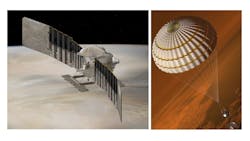Lockheed Martin to help NASA explore Venus with VERITAS and DAVINCI+ spacecraft
DENVER - To learn more about how terrestrial planets evolve over time, NASA selected the VERITAS and DAVINCI+ missions for its Discovery Program, both bound for Venus. Lockheed Martin will design, build and operate both spacecraft. The missions will launch in the 2028-2030 timeframe, and will combine to study Venus' dense atmosphere, topography and geologic processes in great depth.
Both missions will aim to discover how Venus – which may have been the first potentially habitable planet in our solar system – became inhospitable to life. They represent NASA's return to Earth's sister planet after more than three decades.
"We're very grateful for this opportunity to work with NASA and the missions' principal investigators to fully understand how rocky planets evolved and what it means for our planet, Earth," said Lisa Callahan, vice president and general manager of Lockheed Martin's Commercial Civil Space business. "Our team who designed these two spacecraft to study Venus in unprecedented detail – and yield answers to its greatest mysteries – is beyond excited!"
The operations and science for DAVINCI+ – which stands for Deep Atmosphere Venus Investigation of Noble Gases, Chemistry and Imaging Plus – will be managed by NASA's Goddard Space Flight Center in Greenbelt, Maryland.
VERITAS – which stands for Venus Emissivity, Radio Science, InSAR, Topography & Spectroscopy – will have its science and operations managed by NASA's Jet Propulsion Laboratory in Southern California.
